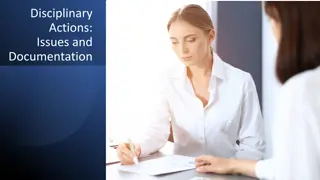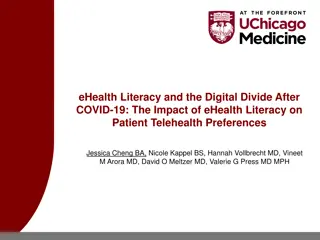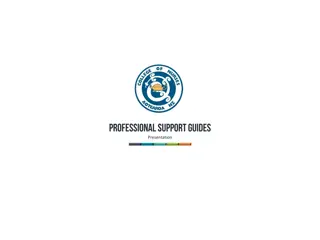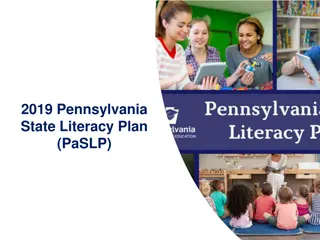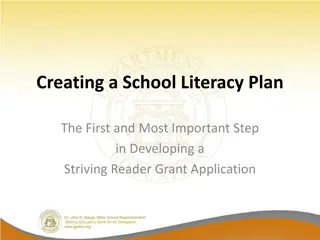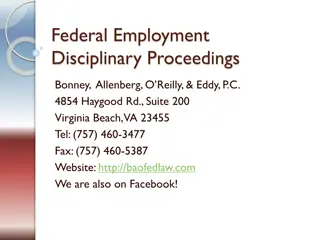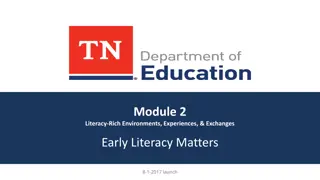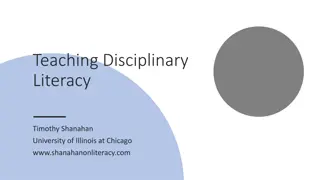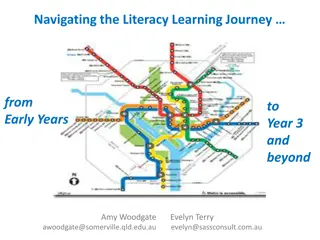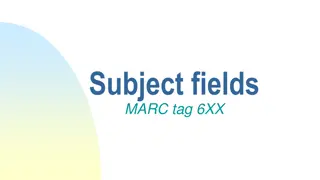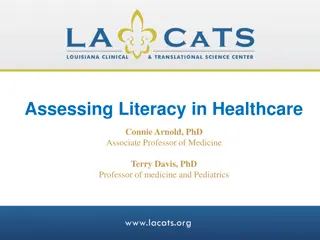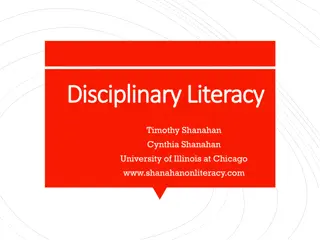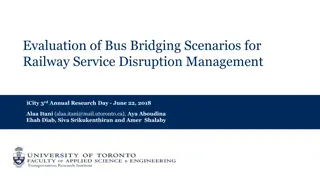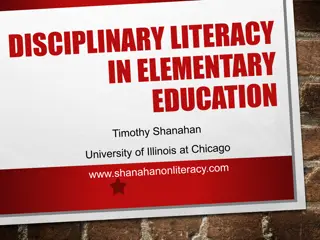Understanding Disciplinary Literacy: Bridging Across Subject Areas
Disciplinary Literacy distinguishes itself from Content Area Literacy by focusing on specific ways each discipline uses text. It aims to apprentice students into various subject-specific ways of creating, disseminating, and evaluating knowledge. This concept challenges educators to teach subject-specific literacy skills rather than applying ELA standards universally in classrooms. The goal is to develop students' ability to engage with challenging texts, analyze information critically, and write effectively across disciplines.
- Disciplinary Literacy
- Literacy Education
- Subject-specific Reading Skills
- Educational Standards
- Academic Literacy
Download Presentation

Please find below an Image/Link to download the presentation.
The content on the website is provided AS IS for your information and personal use only. It may not be sold, licensed, or shared on other websites without obtaining consent from the author. Download presentation by click this link. If you encounter any issues during the download, it is possible that the publisher has removed the file from their server.
E N D
Presentation Transcript
TEACHING DISCIPLINARY LITERACY Timothy Shanahan University of Illinois at Chicago www.shanahanonliteracy.com
Many changes due to Common Core Challenging texts Close reading Writing from sources Informational text Multiple texts Argument Embedded technology Disciplinary literacy
Many changes due to Common Core Challenging texts Close reading Writing from sources Informational text Multiple texts Argument Embedded technology Disciplinary literacy
Many changes due to Common Core Challenging texts Close reading Writing from sources Informational text Multiple texts Argument Embedded technology Disciplinary literacy
Many changes due to Common Core Challenging texts Close reading Writing from sources Informational text Multiple texts Argument Embedded technology Disciplinary literacy
Many changes due to Common Core Challenging texts Close reading Writing from sources Informational text Multiple texts Argument Embedded technology Disciplinary literacy
Content Area Literacy Content area literacy has long championed the idea of every teacher a teacher of reading The approach emphasizes teaching English Language Arts with content texts Focus is on making students better students by building up their reading comprehension and study skills with content textbooks Goal: To make students better students What is the same across the disciplines?
Disciplinary Literacy Disciplinary Literacy is a completely different concept It is not about bringing ELA standards, methods, or approaches to the subject area classroom Each discipline has its own ways of using text to create, disseminate, and evaluate knowledge, and it is this that the new standards are asking us to teach Goal is to apprentice students into the disciplines What is different across the disciplines?
Sources of Disciplinary Literacy Studies that compare expert readers with novices (Bazerman, 1985; Geisler, 1994; Wineburg, 1991, etc.) Functional linguistics analyses of the specialized literacy/language practices used in the disciplines (Fang, 2004; Halliday, 1998; Schleppegrell, 2004, etc.)
Example of Expert Reader Study Wineburg s study of history reading: Sourcing: considering the author and author perspective Contextualizing: placing documents within their historical period and place Corroboration: evaluating information across sources
Science text (Halliday, 2004) Glass cracks more quickly the harder you press on it. Cracks in glass grow faster the more pressure is put on. Glass crack growth is faster if greater stress is applied. The rate of glass crack growth depends on the magnitude of the applied stress. Glass crack growth rate is associated with applied stress magnitude.
Generalizable vs. Specialized Skills Content area reading is based on the idea that reading and writing are highly generalizable skills Thus, literacy can be taught with the texts and content of any field and the same approaches can be applied across the disciplines (e.g., SQ3R, KWL, summarization) But disciplinary literacy focuses not on what is the same across the disciplines, but what is unique or specialized
Chemistry Note-taking Atomic Expression Substances Properties Processes Interactions
Content Area Vocabulary Students need to learn terminology in all fields The same study techniques would accomplish this no matter what the words Graphic organizers, semantic maps, word sorts, rate knowledge of words, analyze semantic features of words, categorizing/mapping words, synonym webs, etc.
Disciplinary Literacy Vocabulary Focus is on specialized nature of vocabulary of the subjects Science: Greek and Latin roots (precise, dense, stable meanings that are recoverable) History: metaphorical terms, terms with a political point of view
Morphology Differs by Discipline Of course, different disciplines use different words But the frequency or value of prefixes, suffixes, and (especially) combining forms differs by discipline See: Word ID: Assessment Across the Content Areas by Linda Gutlohn & Frances Besselieu
Disciplinary Literacy Emphasizes Specialized Nature of Vocabulary Focus is on specialized nature of vocabulary in each subject area Science: Greek and Latin roots (precise, dense, stable meanings that are recoverable) Example: DNA (deoxyribonucleic acid) is a nucleic acid, a macromolecule that stores information.
Specialized Nature of Vocabulary History: metaphorical terms, terms with a political point of view Example: Revolutionary movements in Europe and Asia were described to the American public a examples of Soviet Expansionism . (Zinn, A People s History); Example: Civil War, War between the states, War of Northern aggression. Example: The Gilded Age
Specialized Nature of Vocabulary Literature: Words that evoke emotion, the senses. Example: where I would have lived through all that impassioned, insane joy of the hunt, when as I climb the rock, my face contorted, gasping, shouting voluptuously senseless words (Nabokov, Father s Butterflies).
Teach students to figure out meaning from context Less preteaching of vocabulary More guided practice figuring out word meanings Including figuring out word meanings across a text
Teach students to use reference works Dictionary instruction But using the more specialized reference works from a field of study
Sugar example: General dictionary a sweet crystalline substance obtained from various plants, especially sugar cane and sugar beet, consisting essentially of sucrose, and used as a sweetener in food and drink.
Sugar example: Science dictionary (saccharide) Any of a group of water soluble carbohydrates of relatively low molecular weight and having a sweet taste. The simple sugars are called monosaccharides. More complex sugars comprise between two and ten monosaccharides linked together: disaccharides contain two, trisaccharides, three, and so on. The name is often used to refer specifically to sucrose (cane or beet sugar). The suffix -ose is used in biochemistry to form the names of sugars.
Sugar example: Science dictionary (saccharide) Any of a group of water soluble carbohydrates of relatively low molecular weight and having a sweet taste. The simple sugars are called monosaccharides. More complex sugars comprise between two and ten monosaccharides linked together: disaccharides contain two, trisaccharides three, and so on. The name is often used to refer specifically to sucrose (cane or beet sugar). The suffix -ose is used in biochemistry to form the names of sugars.
Battleship example (History): General dictionary Any of a class of warships that are the Most heavily armored and are equipped With the most powerful armament.
Battleship example: History dictionary U.S. battleship is usually distinguished from its foreign Counterparts by its heavy gun armament, sturdy protection, and relatively slow speed. Three distinct subtypes: 27 mixed-battery ships built 1888-1908; 22 all-big-gun dreadnoughts (1910-1923); and 10 fast battleships (1937-1944). Stricken from the Navy s lists in January 1995. As ship killers, the battleships saw little action; yet they ultimately justified their existence in important subsidiary missions, the most significant being gunfire support for troops ashore.
Paroxysm definition: Literature or Medicine? Literature: a sudden outburst of emotion or action: a paroxysm of laughter Medicine: a sudden onset of a symptom or disease, especially one with recurrent manifestations such as the chills and rigor of malaria
Cultural differences across the disciplines The differences among the disciplines are more than content/information differences They are separated by differences in how information is created, used, evaluated, in the nature of the language, demands for precision, etc. Disciplinary Literacy requires enculturation and acculturation
The Culture of Mathematics Goal: arrive at truth Importance of close reading an intensive consideration of every word in the text Rereading a major strategy Heavy emphasis on error detection Precision of understanding essential
The Culture of Science Text provides knowledge that allows prediction of how the world works Full understanding needed of experiments and processes Close connections among prose, graphs, charts, formulas (alternative representations of constructs an essential aspect of chemistry text) Major reading strategies include corroboration and transformation
The Culture of History History is interpretative, and authors and sourcing are central in interpretation (consideration of bias and perspective) Often seems narrative without purpose and argument without explicit claims (need to see history as argument based on partial evidence; narratives are more than facts) Single texts are problematic (no corroboration)
Character Change Chart What is main character like at the beginning of the story? What is the main character like at the end of the story? How has he or she changed? Crisis Given this character change, what do you think the author wanted you to learn? ________ ________________________________________________________________________ ________________________________________________________________________
History Events Chart TEXT WHO? WHAT? WHERE? WHEN? WHY? 1 Relation: 2 Relation: 3 Relation 4 Main point:
Text is central to disciplines Functional linguists are showing how texts differ across disciplines But secondary teachers are increasingly trying to teach content without text And now, CCSS is requiring the teaching of complex texts
History text (Fang & Scheppegrell) History text constructs time and causation Attributes agency (readers need to focus on the reasons for actions and the outcomes of those actions cause/effect) Presents judgment and interpretation (argument) Often narratives with lack of clear connections to thesis
History text (Fang & Scheppegrell) History also constructs participants/actors and the processes that they engaged in to move towards their goals.
History Reading (Fang & Schleppergrel) Clause 1 Circumstance Over the next decade, Actor further events Some colonial leaders, such as Samuel Adams They Process steadily led Goal Circum. to war 2 favored independ- ence from Britain. 3 encour- aged conflict with British authorities. enemies of many moderate Colonists 4 At the same time, George II and his ministers made by their harsh stands
History text (Fang & Scheppegrell) History also constructs participants/actors and the processes that they engaged in to move towards their goals.
Science text (Fang & Scheppegrell) Technical, abstract, dense, tightly knit language (that contrasts with interactive, interpersonal style of other texts or ordinary language) Nominalization (turning processes into nouns) Passive voice ( the atoms were excited by the heat ) Suppression of agency (readers need to focus on causation not intention)
Science text (Fang & Scheppegrell) Technical, abstract, dense, tightly knit language (that contrasts with interactive, interpersonal style of other texts or ordinary language) Nominalization (turning processes into nouns) Passive voice ( the atoms were excited by the heat ) Suppression of agency (readers need to focus on causation not intention)
Science text (Fang & Scheppegrell) Sentence density: unpacking complex nouns Experimental verification of Einstein s explanation of the photoelectric effect was made 11 years later by the American physicist Robert Millikan. Every aspect of Einstein s interpretation was confirmed, including the direct proportionality of photon energy to frequency.
New standards are an outcome of this work Common Core State Standards for English Language Arts and Literacy in History/Social Studies & Science/Technical subjects
Literacy in History/Social Studies Cite specific textual evidence to support analysis of primary and secondary sources, attending to such features as the date and origin of the information. Analyze in detail a series of events described in a text and the causes that link the events; distinguish whether earlier events caused later ones or simply preceded them. Identify aspects of a text that reveal an author s point of view or purpose (e.g., loaded language, inclusion or avoidance of particular facts). Compare the point of view of two or more authors by comparing how they treat the same or similar historical topics, including which details they include and emphasize in their respective accounts. Interpret the meaning of words and phrases in a text, including how an author uses and refines the meaning of a key term over the course of a text (e.g., how Madison defines faction in Federalist No. 10 and No. 51). Evaluate authors differing points of view on the same historical event or issue by assessing the authors claims, evidence, and reasoning. Distinguish among fact, opinion, and reasoned judgment in a historical account. Compare and contrast treatments of the same topic in several primary and secondary sources. Evaluate an author s premises, claims, and evidence by corroborating or challenging them with other sources of information. Integrate information from diverse sources, both primary and secondary, into a coherent understanding of an idea or event, noting discrepancies among sources. .
Literacy in Science/Technical Subjects Determine the meaning of symbols, key terms, and other domain-specific words and phrases as they are used in a specific scientific or technical texts and topics. Integrate quantitative or technical information expressed in words in a text with a version of that information expressed visually (e.g., in a flowchart, diagram, model, graph, or table). Distinguish among facts, reasoned judgment based on research findings, and speculation in a text. Follow precisely a complex multistep procedure when carrying out experiments, taking measurements, or performing technical tasks, attending to special cases or exceptions defined in the text. Analyze the structure of the relationships among concepts in a text, including relationships among key terms (e.g., force, friction, reaction force, energy). Translate quantitative or technical information expressed in words in a text into visual form (e.g., a table or chart) and translate information expressed visually or mathematically (e.g., in an equation) into words. Compare and contrast findings presented in a text to those from other sources (including their own experiments), noting when the findings support or contradict previous explanations or accounts. Cite specific textual evidence to support analysis of science and technical texts, attending to important distinctions the author makes and to any gaps or inconsistencies in the account. Follow precisely a complex multistep procedure when carrying out experiments, taking measurements, or performing technical tasks; analyze the specific results based on explanations in the text. Synthesize information from a range of sources (e.g., texts, experiments, simulations) into a coherent understanding of a process, phenomenon, or concept, resolving conflicting information when possible.
Literacy in Literature Determine two or more themes or central ideas of a text and analyze their development over the course of the text, including how they interact and build on one another to produce a complex account; provide an objective summary of the text. Analyze the impact of the author s choices regarding how to develop and relate elements of a story or drama (e.g., where a story is set, how the action is ordered, how the characters are introduced and developed). Determine the meaning of words and phrases as they are used in the text, including figurative and connotative meanings; analyze the impact of specific word choices on meaning and tone, including words with multiple meanings or language that is particularly fresh, engaging, or beautiful. (Include Shakespeare as well as other authors.) Analyze how an author s choices concerning how to structure specific parts of a text (e.g., the choice of where to begin or end a story, the choice to provide a comedic or tragic resolution) contribute to its overall structure and meaning as well as its aesthetic impact. Analyze a case in which grasping a point of view requires distinguishing what is directly stated in a text from what is really meant (e.g., satire, sarcasm, irony, or understatement). Analyze multiple interpretations of a story, drama, or poem (e.g., recorded or live production of a play or recorded novel or poetry), evaluating how each version interprets the source text. (Include at least one play by Shakespeare and one play by an American dramatist.) Demonstrate knowledge of eighteenth-, nineteenth- and early-twentieth-century foundational works of American literature, including how two or more texts from the same period treat similar themes or topics.
What about elementary grades? Have kids reading science, history, geography, civics, current events, literature, etc. Focus attention on technical graphics and their relationship to the prose Be explicit about teaching informational text structures and text features Encourage the reading of multiple texts on a topic along with appropriate comparison and synthesis work Teach disciplinary approaches when text availability makes it justifiable
Some History Literacy Resources Stanford History Education Group http://sheg.stanford.edu/rlh Teaching Channel https://www.teachingchannel.org/videos/reading-like-a- historian-repetition Historical Scene Investigation https://web.wm.edu/hsi/index.html
Sam Wineburg, Daisy Martin, & Chauncey Monte-Sano


